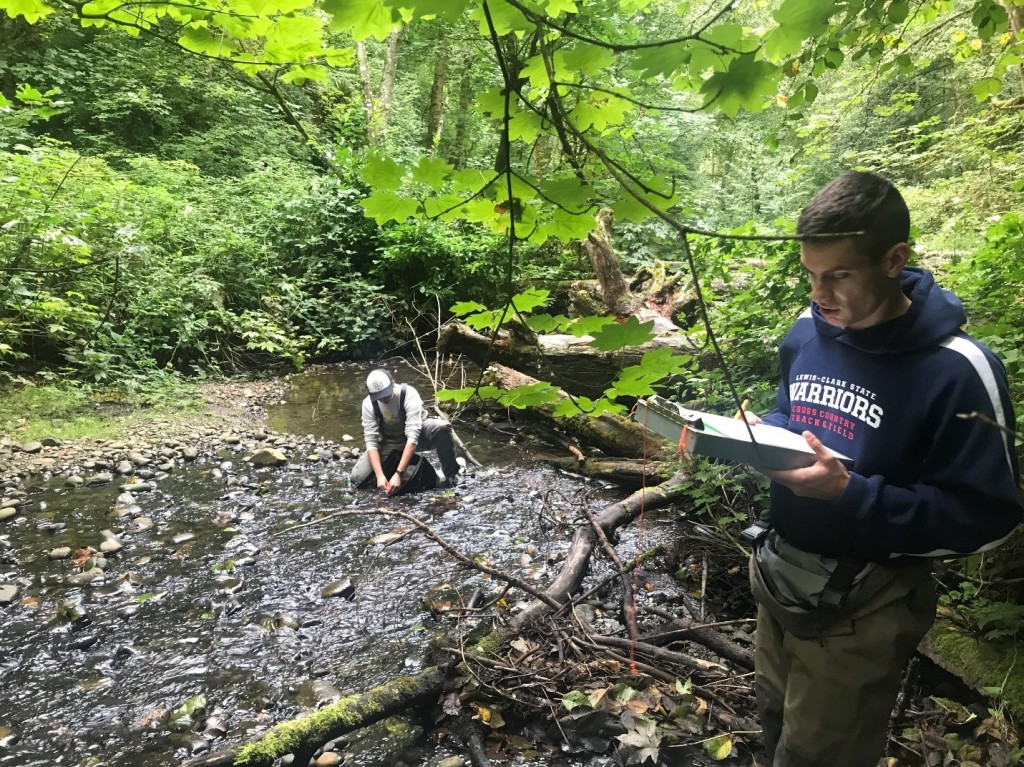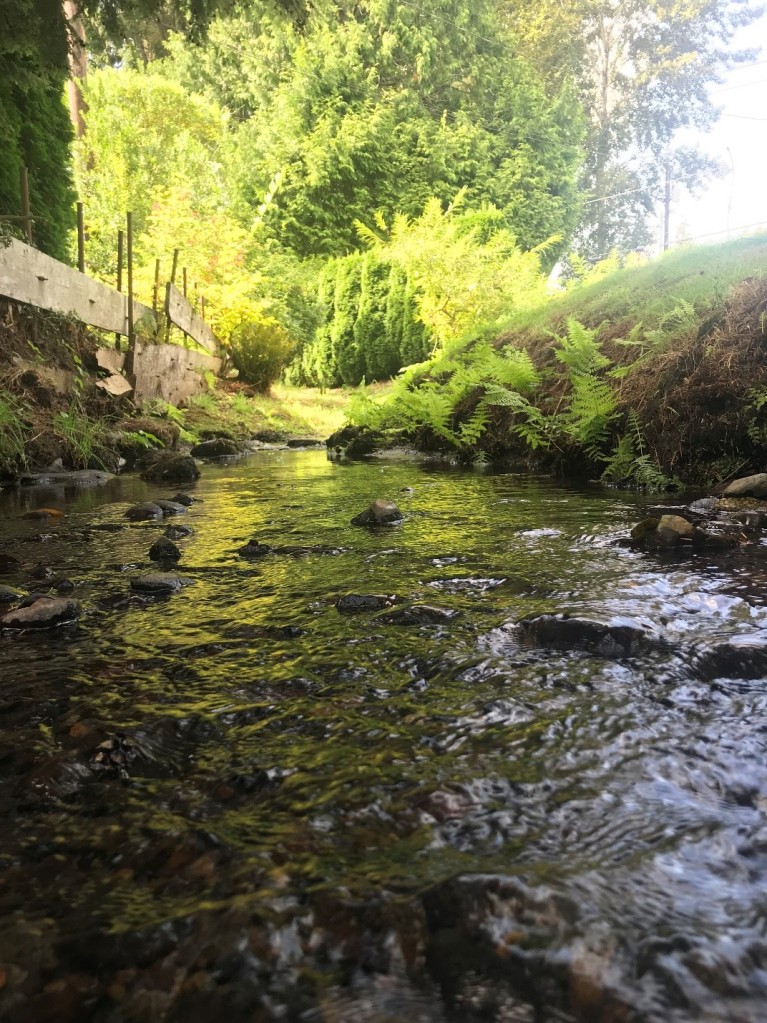By Gavin Tiemeyer

Editor’s note: this story was written prior to the pandemic and social distancing requirements were in place. Team members are currently using masks and social distancing protocols.
Hands down, one of the coolest job at King County is working with the stream bug monitoring program, and arguably one of the most underappreciated.
Stream bugs don’t generate the same hype as salmon or Orcas, but they’re deserving of the same attention. Maybe this has something to do with the fact that most of us associate verbs like squashing, swatting, and killing with the word bugs. Regardless of how we humans feel about them, bugs rule the world, and we’d be wiser to learn to share it with them.
King County’s stream bug monitoring team thinks differently about bugs. They recognize the important role bugs play as indicators of the health of Washington’s watersheds.
On this field day, members of King County’s Stream Team collected samples from a handful of streams in Bellevue, Washington. Their first stop was the Coal Creek Natural Area, an urban greenspace that is just big enough that you forget you’re in a major metropolitan city.
The team was looking for benthic macroinvertebrates – think bottom dwelling bugs that live in the gravel, wood, and other debris in a stream. The team is particularly interested in documenting bugs that live in the riffles of the stream.
“The bugs we want to find are more diverse and plentiful in riffles,” explains Emily Rahlmann, a seasonal Stream Team member. A riffle is important habitat where fast moving water supplies plenty of oxygen that stream bugs to need to survive.
But why care about the little creepy crawlers in a stream?
“Bugs are super good indicators of what is going on in a stream, as well as the whole health of the watershed,” Tristan Hites, another seasonal Stream Team member explains. He’s right. The presence or lack of stream bugs says a lot about the health of a stream, and the larger ecosystem. According to the stream bug monitoring program, “bugs play a crucial role in the stream nutrient cycle. If bug populations are suffering it will affect the whole ecosystem.” That means that without bugs, growing fish have nothing to eat, and without fish, ocean predators have nothing to eat, and so on and so forth in a trophic cascade that is bad for everyone, including us.

The teams work in twos and will sample an area of the stream containing four riffles. One team member will collect bug samples from a riffle using a tool called a Surber sampler while the other team member will take measurements of the stream and outlying area in order to learn more about overall health of the surrounding ecosystem. When they move to a new stream, they alternate responsibilities.

Emily starts with the Surber sampler, a net fixed to a square brass frame that when seated firmly against the streambed allows water to flow into a plastic receptacle at the net’s end. She explains the Surber sampler is handmade by a local company and it is arguably the most valuable tool they have. One worth taking care of. Oh yeah – one crucial step to this process is digging up the riffle with a “weed tool” in order to shake loose the tiny benthic insects hiding in the streambed. Under a one-minute time interval, Emily digs the weed tool vigorously into the riffle and a brown plume of pebbles and fine sediment flow through the Surber into the plastic receptacle.

Downstream, Tristan, who holds a degree in wildlife biology degree, takes measurements of the streambed, using a variety of nifty, low-tech instruments. They work with a calm and collected ease, the movements of professionals who have perfected their craft through repetition. Tristan makes quick use of the stadia rod and measuring tape to document instream features such as riffle depth and stream width.

Dr. Kate Macneale, an Environmental Scientist and the lead of King County’s Stream Bug Monitoring Program, explained how the seasonal work is done with a small team. Out of a large pool of applicants for the seasonal work, team members are chosen for their unique qualifications and ability to perform the important job.
Both Emily and Tristan speak fondly of their team leads. “They’re both very enthusiastic about their bugs – especially Kate,” reflects Emily. “Kate gets very excited when we find big stoneflies.” A stonefly is to a stream what a canary is to a coal mine. Stoneflies are great indicators of stream health because they’re so sensitive to the fine silt and pollution that run off roads and into streams when it rains.
Emily dumps the contents from the riffles she’s sampled into a white rubber tub and begins the process of separating pebbles from the more important things that will be sent to the lab for analysis. Mayfly, stonefly, and caddisfly nymphs are good signs. Samples dominated by midges and worms, however, indicate water and habitat conditions are not so good. Tristan and Emily also keep an eye out for New Zealand mud snails in order to document the spread of the invasive species.

So far, no signs of big stoneflies, just a couple of caddisflies. But Emily points to something else blending in among the other pebbles. A vertebrate. A fish. “A sculpin!” Emily pronounces. The tiny fish is no bigger than your thumb. Here, in the middle of a densely populated city lives this unique animal, just like its predecessors have done for eons. Emily gently places it back into the stream, protocol if you catch a live fish.

“Oh yeah, we gotta show you the pebble count,” Tristan says with a smile.
The pebble count is the most charming task of the stream bug monitoring team. Not because it’s fun but because of the way Tristan and Emily deal with the monotony of the task. The Wolman pebble count (to be exact) is a method used to measure the diversity of the stream’s substrate. A team member must pick 100 pebbles at random and measure each pebble’s diameter by pushing it through a size slot in a metal frame called a gravelometer. If the pebble fits you have a measurement. Pebble measurements are documented by the other team member using the slot’s corresponding letter.
“But sometimes the noise of the stream can get in the way,” Tristan explains. “The letter B and D sound similar so it’s easier to come up with names.”
Tristan picks up a rock. “Kathryn.” He picks up another rock, and another. “Judith, Frankie, Judith, Judith, Frankie, Gordon, Horris, Ethel, Kathryn, Astrid, Judith, Kathryn, Lucile, Michael…” And so on and so forth until 100 pebbles are counted.
“Sometimes we use the names of snacks, but get too hungry,” Emily adds.

The last stream the team sampled is squeezed between two residential properties close to Lake Sammamish. It doesn’t scream nature as much as the Coal Creek Natural Area. There aren’t many trees to provide habitat for insects and fish and the banks have been reinforced. Still, there is something special about it. Despite the developing landscape around the stream, a tiny, hidden world of life persists. If you look down at the moving water and squint your eyes you can almost see it. Tristan and Emily get to work: Seat the Surber sampler in the riffle, collect the sample, and take measurements of the stream. One riffle, two riffle, three riffle four. If they’re not here now, maybe the mayfly, stonefly, and caddisfly – the tiny indicators of the stream ecosystem—will return. Our future looks better if they do.
In May 2020, the Stream Bug Monitoring Program published a project report that studied how the health of several historically degraded King County streams could be improved by seeding them with a diverse community stream bugs from healthy streams. Read Bug Seeding: A Possible Jump-start to Stream Recovery.
Gavin Tiemeyer is a graduate of The Evergreen State College where he studied environmental communication. He was a communications intern with the King County Department of Natural Resources and Parks where he spent time in the field with employees of the Water and Land Resources Division to detail a fraction of the work they do along rivers and streams to ensure clean water and healthy habitat in King County.
![Help wanted: Must love benthic macroinvertebrates. [The Water and Land Resources Division at work.]](https://kingcountywaterandland.wordpress.com/wp-content/uploads/2020/09/sb-3.jpg?w=825&h=510&crop=1)